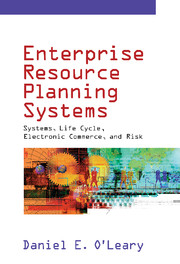Book contents
- Frontmatter
- Contents
- Acknowledgments
- PART ONE INTRODUCTION AND BACKGROUND
- PART TWO ERP SYSTEMS
- PART THREE ERP LIFE CYCLE
- 7 Deciding to Go ERP
- 8 Choosing an ERP System
- 9 Designing ERP Systems: Should Business Processes or ERP Software Be Changed?
- 10 Designing ERP Systems: Choosing Standard Models, Artifacts, and Processes
- 11 Implementing ERP Systems: Big Bang versus Phased
- 12 After Going Live
- 13 Training
- PART FOUR ELECTRONIC COMMERCE AND RISK
- Index
11 - Implementing ERP Systems: Big Bang versus Phased
from PART THREE - ERP LIFE CYCLE
Published online by Cambridge University Press: 05 June 2012
- Frontmatter
- Contents
- Acknowledgments
- PART ONE INTRODUCTION AND BACKGROUND
- PART TWO ERP SYSTEMS
- PART THREE ERP LIFE CYCLE
- 7 Deciding to Go ERP
- 8 Choosing an ERP System
- 9 Designing ERP Systems: Should Business Processes or ERP Software Be Changed?
- 10 Designing ERP Systems: Choosing Standard Models, Artifacts, and Processes
- 11 Implementing ERP Systems: Big Bang versus Phased
- 12 After Going Live
- 13 Training
- PART FOUR ELECTRONIC COMMERCE AND RISK
- Index
Summary
“Phased” and “big bang” are the two primary (and contrasting) approaches used to implement ERP systems. This chapter investigates what these terms mean, some properties of each approach, and some of the advantages and disadvantages of each. This chapter also analyzes the choice of the implementation methodology in light of organization size, complexity, and structure and in terms of the overall extent of the implementation. Finally, some additional terms and approaches used to implement ERP systems are discussed briefly.
What Is a Big-Bang Implementation?
In a full big-bang implementation, an entire suite of ERP applications is implemented at all locations at the same time. Using big bang, the system goes from being a test version to being the actual system used to capture transactions in only a matter of days (hence the name “big bang”). Big bang requires simultaneous implementation of multiple modules. In the case of Quantum (see the appendices of this chapter), this meant implementing 17 modules of Oracle applications at 23 sites around the world over a period of about one week. Under this scenario, big bang requires a large amount of testing before cutting over from legacy systems to the new system. In the case of Quantum, this meant six to eight months of system testing prior to going “live” and actually using it to process transactions.
- Type
- Chapter
- Information
- Enterprise Resource Planning SystemsSystems, Life Cycle, Electronic Commerce, and Risk, pp. 151 - 171Publisher: Cambridge University PressPrint publication year: 2000



